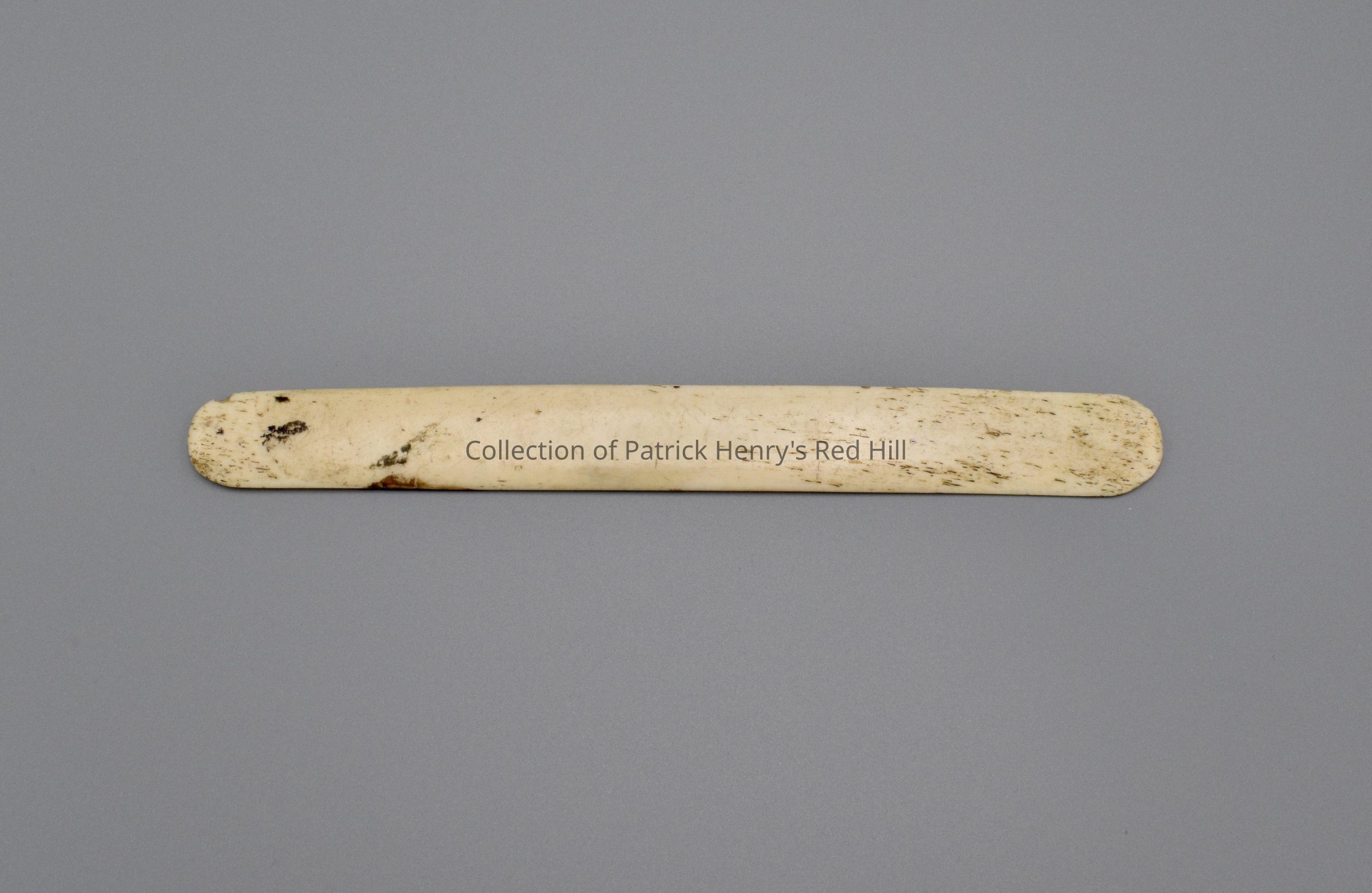Notes
This paper cutter, sometimes incorrectly referred to as a letter opener, was held by Patrick Henry on March 23, 1775, when he delivered his "Give me liberty or give me death" speech at St. John's Church in Richmond, Virginia.
Robert Douthat Meade first mentioned the cutter in "Patrick Henry: Practical Revolutionary" (1969). He writes, “As Henry exclaimed ‘Give me liberty…’ he held aloft an ivory letter opener, letting it sink slowly into his breast at the word ‘death.’” He adds, “Henry’s use of the paper cutter was not overly dramatic; it did not disturb his tone of burning simplicity.” In the book’s endnotes, Meade says that Charles Spurgeon Borum Sr. (1902–1976), then of Arlington, Virginia, showed him the paper cutter in 1952 and shared with him the story of how Patrick Henry used the object during “Liberty or Death.” Borum's story had been passed down through the family and convincingly documented as early as 1859.
Col. William Winston Fontaine Sr. (1834–1917) is the primary source for the written provenance of this artifact. His maternal grandmother was Elizabeth "Betsey" Henry Aylett (1769–1842), the fifth child of Patrick and his first wife, Sarah Shelton Henry (1738–1775). His paternal great-grandmother was Elizabeth’s sister, Martha Henry Fontaine (1755–1818), the oldest of Patrick and Sarah’s six children. It passed down to Charles Spurgeon Borum Sr., great-grandson of the same William Winston Fontaine. Mr. Borum is descended from Patrick Henry on both sides of his family, from Patrick Henry's oldest daughter, Martha Henry Fontaine, and his younger daughter, Elizabeth Henry Aylett.
According to Fontaine's diary, Saturday, February 19, 1859, was his second day visiting Williamsburg, Virginia. After breakfast, he met an old friend of his father, Hugh Blair Grigsby (1806–1881), who is best known to historians as the author of several books, including "The Virginia Convention of 1776" (1855) and "The History of the Virginia Federal Convention of 1788" (1890). Grigsby, in turn, introduced the 26-year-old Fontaine to former President John Tyler (1790–1862), whose father was a friend and colleague of Patrick Henry’s. President Tyler, at this time 14 years removed from office, “invited me to call at his room, as he wished to tell me something about Colonel Henry, which, perhaps, I had never heard.” After leaving his friends, Fontaine accompanied Mr. Tyler to the house where he was staying.
The former president shared an account of Patrick Henry’s “Liberty or Death” speech as he had no doubt heard from his father, John Tyler Sr. (1747–1813). The senior Tyler was a fellow delegate to the Second Virginia Convention, where Henry delivered his now famous remarks on March 23, 1775. The vivid description recorded in Fontaine’s diary contained a detailed explanation of Henry’s remarks and his use of the “paper cutter” as a dagger. Fontaine was very appreciative of the story and how it confirmed what he had heard from his grandmother, Elizabeth, as well as his father, who had heard the story from Virginia Senator William Henry Roane (1787–1845), whose mother, Anne Henry Roane (1767–1799) was a sister of Martha and Elizabeth Henry.
William Fontaine then shared with Mr. Tyler that he owned the paper cutter that was being talked about and an army desk that the Marquis de Lafayette had given Patrick Henry in 1784 while visiting Richmond. Henry was the committee chairman appointed to host the Marquis during his visit. A year later, in 1861, as a member of the Secession Convention in Richmond, Tyler visited Fontaine to see the paper cutter, as well as the Lafayette desk. During the visit, with Patrick Henry’s paper cutter in his hand, the former president recited the latter part of the famous speech for those present.
In December 1906, Col. Fontaine wrote a letter of response to his daughter Elizabeth Henry Fontaine (1873–1916), who lived in Galveston, Texas. Elizabeth had written and inquired of her father about Patrick Henry's famous speech. In reply, he relayed the account of the speech and re-told the story of meeting President Tyler, focusing on Patrick Henry's "Liberty or Death" and specifically the story of the paper cutter, which was now in Elizabeth’s possession.
The paper cutter was only first mentioned by a biographer in 1969, but the story has been passed down through different sources, all confirming one another. President Tyler remarked to William Winston Fontaine, “You own a great historic treasure my boy.”
Charles Spurgeon Borum Sr. and his wife, Marie Thompson Clark (1899–1989), donated the paper cutter to the PHMF on October 16, 1975.
